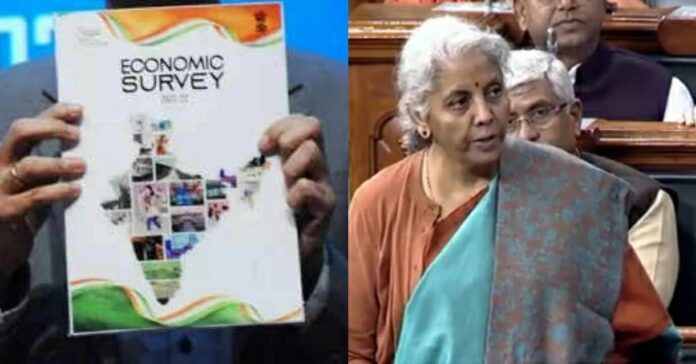Economic Survey 2023 key highlights : Ahead of the Budget 2023’s presentation by Finance Minister Nirmala Sitharaman, the Economic Survey 2023 was presented today, on January 31, 2023. The Survey has pegged India’s GDP growth for FY24 at 6-6.8 per cent.
The Economic Survey is an annual economic report card that is given a day before the budget and assesses the performance of each sector and suggests the future steps to be taken. Here’s the key highlights of Economic Survey 2023
Here’s the Economic Survey 2023 key highlights
State of the Economy : GDP Growth
• India’s GDP growth is expected to remain robust in FY24. GDP forecast for FY24 to be in the range of 6-6.8 %.
• Private consumption in H1 is highest since FY15 and this has led to a boost to production activity resulting in enhanced capacity utilisation across sectors.
• The credit growth to the MSME sector was over 30.6 per cent on average during Jan-Nov 2022.
• Retail inflation is back within RBI’s target range in November 2022.
• Indian Rupee performed well compared to other Emerging Market Economies in Apr-Dec2022.
• Direct Tax collections for the period April-November 2022 remain buoyant.
• Enhanced Employment generation seen in the declining urban unemployment rate and in the faster net registration in Employee Provident Fund.
• Economic growth to be boosted from the expansion of public digital platforms and measures to boost manufacturing output.
• The period of 2014-2022 also witnessed balance sheet stress caused by the credit boom in the previous years and one-off global shocks, that adversely impacted the key macroeconomic variables such as credit growth, capital formation, and hence economic growth during this period.
• Indian economy has also started benefiting from the efficiency gains resulting from greater formalisation, higher financial inclusion, and economic opportunities created by digital technology-based economic reforms.
Fiscal Developments: Revenue Relish
• The Gross Tax Revenue registered a YoY growth of 15.5 percent from April to November 2022, driven by robust growth in the direct taxes and Goods and Services Tax (GST).
• Growth in direct taxes during the first eight months of the year was much higher than their corresponding longer-term averages.
• GST has stabilized as a vital revenue source for central and state governments, with the gross GST collections increasing at 24.8 percent on YoY basis from April to December 2022.
• The Union Government’s emphasis on capital expenditure (Capex) has continued despite higher revenue expenditure requirements during the year. The Centre’s Capex has steadily increased from a long-term average of 1.7 percent of GDP (FY09 to FY20) to 2.5 percent of GDP in FY22 PA.
Monetary Management and Financial Intermediation: A Good Year
• The RBI initiated its monetary tightening cycle in April 2022 and has since raised the repo rate by 225 bps, leading to moderation of surplus liquidity conditions.
• Cleaner balance sheets led to enhanced lending by financial institutions.
• The growth in credit offtake is expected to sustain, and combined with a pick-up in private capex, will usher in a virtuous investment cycle.
• Non-food credit offtake by scheduled Commercial Banks (SCBs) has been growing in double digits since April 2022.
• Credit disbursed by Non-Banking Financial Companies (NBFCs) has also been on the rise.
• The Gross Non-Performing Assets (GNPA) ratio of SCBs has fallen to a seven-year low of 5.0.
• The Capital-to-Risk Weighted Assets Ratio (CRAR) remains healthy at 16.0.
• The recovery rate for the SCBs through Insolvency and Bankruptcy (IBC) was highest in FY22 compared to other channels.
Prices and Inflation: Successful Tight-Rope Walking
• IIndia’s retail inflation rate peaked at 7.8 percent in April 2022, above the RBI’s upper tolerance limit of 6 per cent, the overshoot of inflation above the upper end of the target range in India was however one of the lowest in the world.
• The government adopted a multi-pronged approach to tame the increase in price levels
• Phase wise reduction in export duty of petrol and diesel
• Import duty on major inputs were brought to zero while tax on export of iron ores and concentrates increased from 30 to 50 per cent
• Waived customs duty on cotton imports w.e.f 14 April 2022, until 30 September 2022
• Prohibition on the export of wheat products under HS Code 1101 and imposition of export duty on rice
• Reduction in basic duty on crude and refined palm oil, crude soya bean oil and crude sunflower oil
• The RBI’s anchoring of inflationary expectations through forward guidance and responsive monetary policy has helped guide the trajectory of inflation in the country.
• The one-year-ahead inflationary expectations by both businesses and households have moderated in the current financial year.
• Timely policy intervention by the government in the housing sector, coupled with low home loan interest rates propped up demand and attracted buyers more readily in the affordable segment in FY23.
Also Read :Economic Survey 2023: significance and who prepares it ?
Social Infrastructure and Employment:
• Social Sector witnessed a significant increase in government spending.
• The Central and State Government’s budgeted expenditure on health sector touched 2.1% of GDP in FY23 (BE) and 2.2% in FY22 (RE) against 1.6% in FY21.
• Social sector expenditure increases to Rs. 21.3 lakh crore in FY23 (BE) from Rs. 9.1 lakh crore in FY16.
• The Aspirational Districts Programme has emerged as a template for good governance, especially in remote and difficult areas.
• JAM (Jan-Dhan, Aadhaar, and Mobile) trinity, combined with the power of DBT, has brought the marginalized sections of society into the formal financial system, revolutionizing the path of transparent and accountable governance by empowering the people.
• Aadhaar played a vital role in developing the Co-WIN platform and in the transparent administration of over 2 billion vaccine doses.
Unemployment Rate Falling:
• Labor markets have recovered beyond pre-Covid levels, in both urban and rural areas, with unemployment rates falling from 5.8 per cent in 2018-19 to 4.2 per cent in 2020-21.
Education:
* The year FY22 saw improvement in Gross Enrolment Ratios (GER) in schools and improvement in gender parity. GER in the primary-enrolment in class I to V as a percentage of the population in age 6 to 10 years – for girls as well as boys have improved in FY22.
Health:
• Due to several steps taken by the government on health, out-of-pocket expenditure as a percentage of total health expenditure declined from 64.2% in FY14 to 48.2% in FY19.
• Infant Mortality Rate (IMR), Under Five mortality rate (U5MR) and neonatal Mortality Rate (NMR) have shown a steady decline.
• More than 220 crore COVID vaccine doses administered as on 06 January, 2023.
• Nearly 22 crore beneficiaries have been verified under the Ayushman Bharat Scheme as on 04 January, 2023. Over 1.54 lakh Health and Wellness Centres have been operationalized across the country under Ayushman Bharat.
Exports Surging
• Surge in growth of exports in FY22 and the first half of FY23 induced a shift in the gears of the production processes from mild acceleration to cruise mode.
• Electronics exports rose nearly threefold, from US $4.4 billion in FY19 to US $11.6 Billion in FY22.
Climate Change and Environment: Preparing to Face the Future
• India declared the Net Zero Pledge to achieve net zero emissions goal by 2070.
• India achieved its target of 40 per cent installed electric capacity from non-fossil fuels ahead of 2030.
• The likely installed capacity from non-fossil fuels to be more than 500 GW by 2030 resulting in decline of average emission rate by around 29% by 2029-30, compared to 2014-15.
• India to reduce emissions intensity of its GDP by 45% by 2030 from 2005 levels.
• About 50% cumulative electric power installed capacity will come from non-fossil fuel-based energy resources by 2030.
• A mass movement LIFE– Life style for Environment launched.
• Sovereign Green Bond Framework (SGrBs) issued in November 2022.
• RBI auctions two tranches of ₹4,000 crore Sovereign Green Bonds (SGrB).
• National Green Hydrogen Mission to enable India to be energy independent by 2047.
• Green hydrogen production capacity of at least 5 MMT (Million Metric Tonne) per annum to be developed by 2030. Cumulative reduction in fossil fuel imports over ₹1 lakh crore and creation of over 6 lakh jobs by 2030 under the National Green Hydrogen Mission. Renewable energy capacity addition of about 125 GW and abatement of nearly 50 MMT of annual GHG emissions by 2030.
• The Survey highlights the progress on eight missions under the NAP on CC to address climate concerns and promote sustainable development.
• Solar power capacity installed, a key metric under the National Solar Mission stood at 61.6 GW as of October 2022.
• 62.8 lakh individual household toilets and 6.2 lakh community and public toilets constructed (August 2022) under the National Mission on Sustainable Habitat.
Agriculture and Food Management
• Private investment in agriculture increases to 9.3% in 2020-21.
.• MSP for all mandated crops fixed at 1.5 times of all India weighted average cost of production since 2018.
Institutional Credit to the Agricultural Sector continued to grow to 18.6 lakh crore in 2021-22
Foodgrains production in India saw sustained increase and stood at 315.7 million tonnes in 2021-22.
• Free foodgrains to about 81.4 crore beneficiaries under the National Food Security Act for one year from January 1, 2023.About 11.3 crore farmers were covered under the Scheme in its April-July 2022-23 payment cycle.
• Rs 13,681 crores sanctioned for Post-Harvest Support and Community Farms under the Agriculture Infrastructure Fund.
• Online, Competitive, Transparent Bidding System with 1.74 crore farmers and 2.39 lakh traders put in place under the National Agriculture Market (e-NAM) Scheme.
• Organic Farming being promoted through Farmer Producer Organisations (FPO) under the Paramparagat Krishi Vikas Yojana (PKVY).
Highlight of other important sectors
• India’s e-commerce market is projected to grow at 18 per cent annually through 2025
• Merchandise exports of US$ 332.8 billion for April-December 2022
• India is the largest recipient of remittances globally receiving US$ 100 billion in 2022
• PM GatiShakti National Master Plan creates comprehensive database for integrated planning and synchronized implementation across Ministries/ Departments
• UPI-based transactions grew in value (121 per cent) and volume (115 per cent) terms, between 2019-2022, paving the way for its international adoption

